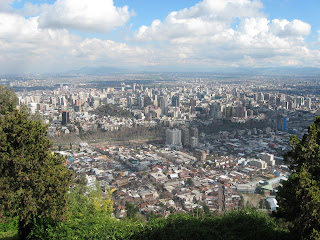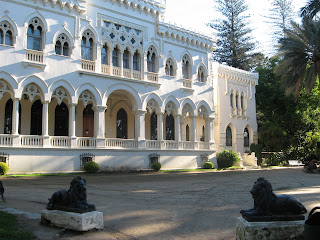
I got back yesterday from the last trip of my trip. I went to the south of Chile, just to the gateway to Patagonia, to the islands of Chiloé, and then up again to Pucón, which is the adventure capital of Chile. Chiloé was at the top of my list of places to visit in Chile for lots of reasons. First, from what I had heard, it was incredibly beautiful, with the Pacific on one side and a long bay between it and the mainland of Chile, with one large island and around 40 smaller ones, all rolling green hills. It didn’t disappoint. With a friendly and informative guide originally from

New York state who now lives in Chiloé with his Peruvian wife and kids, we took a hike along the coast with gorgeous views of the ocean, lots of happy cows and sheep, and beaches where only a few people come each year, with dark pebbly sand and purple shells. During the same tour we went out in a boat to experience another of the joys of Chiloé: penguins!! We saw dozens of penguins (plus other interesting birds and some sea otters) in their natural habitat, hopping around on the rocks on several tiny islands and swimming in the glassy-clear, cold water. I decided that if I’m ever a bird I’ll come down and live on Chiloé because it seems like a big party.

Four other aspects attracted me to Chiloé, all of them to do with the unique culture. One is curanto, a typical dish of the islanders (Chilotes), which is cooked on hot rocks in a hole in the earth, covered with a species of giant leaf that we later noticed growing all over the island. Curanto has everything: lots of mussels and clams (which I admit I’m not fond of, so that part was wasted on me), chicken, ham, sausage, and finally potato pancakes that get cooked in the upper layers of leaves. To see this being made (and then eat it), we took a boat trip out to a small island called Mechuque, where there is only electricity between 8 and 10 at night, in part so that the islanders can watch the most important telenovelas. The boat trip there was beautiful because we could see the green hills of the smaller islands and also, in the distance, we could just barely make out the snowy mountains of the Andes, which looked like they came right out of the water.

The churches of Chiloé are Patrimonio de la Humanidad (World Heritage sites, like in Valparaíso). There are about 20 of them I think, of which I saw 5 or 6, all wooden and most of them with tall round spires and bright paint jobs. This blue one is right by the ocean. Inside a church in Dalcahue, we found this crazy painting of Jesus with four of the mythological crea

tures of Chiloé; the mythology of the islands is totally unique and quite expansive. In the upper left corner is Trauco, a short, ugly gnome who seduces virgins. Pincoya is at bottom left; she is the beautiful goddess of the fertility of the waters. At bottom right is El Caleuche, the ghost ship that haunts the waters of Chiloé, and at top right is Camahueto, a beautiful bull/unicorn. There are lots of stories about brujos (witches) and many superstitions. The whole feel of the mythology is pretty dark and spooky, helped out by the fact that Chiloé is so isolated from the mainland.

Another thing about Chiloé is its houses, called palafitos, which are built on stilts over the beaches. Most of the time you can see the structure below them, but when the tide comes in the boats can float up close to the back doors—which I didn’t get to see, but I love the idea. From the street side, the houses look like any other. We saw these in the town of Castro, where we also some men building by hand three of the wooden boats like the ones we saw all over the islands painted bright colors. That is the other thing that attracts me to Chiloé: it’s stuck in time, and the people do many jobs the way they have been done for generations. And to top off this part of the trip, we saw two giant waterfalls on the way back from Mechuque.
Then, after an 11-hour bus ride that should only have taken 8, we got to Pucón. Pucón is a very touristy town, but one of the most beautiful little cities I’ve ever been to. On one side you can see the snowy, perfectly shaped Volcán Villarica (It is always active and smoking, but has not erupted since 1984; there is a green-yellow-red warning system in town in case of another eruption). On the other side is a blue lake with a volcanic sand beach, surrounded by green hills. The style of the buildings is like alpine/Camp Snoopy/Paul Bunyan, everything made out of wood—and there’s lots of good food.

The first day we went white-water rafting, which was new for me and lots of fun. The hardest part of the whole thing was getting the wetsuit on; after that, even though I fell out of the raft a few times (sometimes because the guides in other boats would sneak up on us and pull us out during the calm parts), or because of that, it was great. The next day, we got up at 4:30 AM to attempt something I had plenty of doubts about at the time: climbing Volcán Villarica. I made it to the top, but it was absolutely grueling—almost impossible to believe that our guide did it every single day. It took about 6 hours of straight climbing to reach the smoking, sulfurous crater. When we started, we were already above the clouds, and when we got to the top more than 1 kilometer up, it was like the top of the world. All along the way I was more than a little nervous, because we had to step in the snow-footprints of the person in front of us, because slipping outside of them could mean sliding all the way down the volcano on the steep sheet of ice.

But it was worth it, because coming down was incredibly fun. We got to slide down on our butts the whole way, sort of in a bobsled chute carved out by other people’s butts. We got going REALLY fast, and it was as if we were shooting into the mountains and clouds in the distance, because it was so steep we couldn’t see the bottom of the volcano from the top. It was ridiculous…and I took a nap at the hostel when we finally got back down.
Now…I’m back in Viña and I only have until Sunday afternoon in Chile! I finished my last test yesterday and now it’s time to pack and say goodbye. What makes me really happy (in a bittersweet way, because why does this only happen when I have to leave??) is that my Chilean friend Daniela invited me to her house for almuerzo (lunch) on Saturday, so I get to meet her family.










































